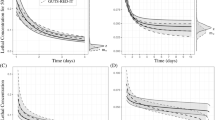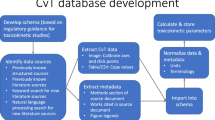Abstract
The ability to predict the effects of toxicants in organisms with reasonable accuracy depends to a great extent on the toxico-kinetic models used to describe such effects. Toxic effects of organic chemicals and heavy metals have been described adequately using a hyperbolic model that considers the concentration of the toxicant and the time of exposure only. Such a model relies on the median time to effect (ET50) of a chemical to estimate effects at any exposure time, but cannot make predictions for concentrations other than those tested experimentally. A complementary log-to-log model can calculate all ET50 values for a toxicant, thus enabling the hyperbolic model to predict any level of effect for any combination of concentrations and times of exposure. The parameter values used in both models are obtained from experimental bioassays where the time-to-effect of a toxicant is recorded regularly in addition to standard acute or chronic toxicity data. These models will facilitate the risk assessment of chemicals by (1) predicting effects under any combination of time and concentrations, and (2) reducing to a minimum the experimental efforts required to obtain comprehensive ecotoxicity data.





Similar content being viewed by others
References
Bedaux JJM, Kooijman SALM (1994) Statistical analysis of bioassays based on hazard modelling. Environ Ecol Stat 1:303–314. doi:10.1007/BF00469427
Beketov MA, Liess M (2008) Acute and delayed effects of the neonicotinoid insecticide thiacloprid on seven freshwater arthropods. Environ Toxicol Chem 27:461–470. doi:10.1897/07-322R.1
Bliss CI (1937) The calculation of the time–mortality curve. Ann Appl Biol 24:815–852
Bonnomet V, Duboudin C, Magaud H, Thybaud E, Vindimian E, Beauzamy B (2002) Modelling explicitly and mechanistically median lethal concentration as a function of time for risk assessment. Environ Toxicol Chem 21:2252–2259. doi:10.1897/1551-5028(2002)021<2252:MEAMML>2.0.CO;2
Breck JE (1988) Relationships among models for acute toxic effects: applications to fluctuating concentrations. Environ Toxicol Chem 7:775–778. doi:10.1897/1552-8618(1988)7[775:RAMFAT]2.0.CO;2
Brent RN, Herricks EE (1998) Postexposure effects of brief cadmium, zinc and phenol exposures on freshwater organisms. Environ Toxicol Chem 17:2091–2099. doi:10.1897/1551-5028(1998)017<2091:PEOBCZ>2.3.CO;2
Brisbin IL Jr (1990) Applications of a modified Richards sigmoid model to assess the uptake and effects of environmental contaminants upon birds. In: Kendall RJ, Larcher TE (eds) Wildlife toxicology and population modeling. Lewis Publishers, Boca Raton, pp 161–170
Brown VM, Jordan DHM, Tiller BA (1969) The acute toxicity to rainbow trout of fluctuating concentrations and mixtures of ammonia, phenol and zinc. J Fish Biol 1:1–9. doi:10.1111/j.1095-8649.1969.tb03837.x
Chaisuksant Y, Yu Q, Connell D (1997) Internal lethal concentrations of halobenzenes with fish (Gambusia affinis). Ecotoxicol Environ Saf 37:66–75. doi:10.1006/eesa.1997.1524
Connolly JP (1985) Predicting single-species toxicity in natural water systems. Environ Toxicol Chem 4:573–582. doi:10.1897/1552-8618(1985)4[573:PSTINW]2.0.CO;2
Daniels RE, Allan JD (1981) Life table evaluation of chronic exposure to a pesticide. Can J Fish Aquat Sci 38:485–494. doi:10.1139/f81-070
Dixon PM, Newman MC (1991) Analyzing toxicity data using statistical models for time-to-death: an introduction. In: Newman MC, McIntosh AW (eds) Metal ecotoxicology. Concepts and applications. Lewis Publishers, Chelsea, pp 207–242
Forbes VE, Calow P, Sibly RM (2001) Are current species extrapolation models a good basis for ecological risk assessment? Environ Toxicol Chem 20:442–447. doi:10.1897/1551-5028(2001)020<0442:ACSEMA>2.0.CO;2
Grant A (1998) Population consequences of chronic toxicity: incorporating density dependence into the analysis of life table response experiments. Ecol Model 105:325–335. doi:10.1016/S0304-3800(97)00176-2
Hickie BE, McCarty LS, Dixon DG (1995) A residue-based toxicokinetic model for pulse–exposure toxicity in aquatic systems. Environ Toxicol Chem 14:2187–2197. doi:10.1897/1552-8618(1995)14[2187:ARTMFP]2.0.CO;2
Hoang TC, Tomasso JR, Klaine SJ (2007) An integrated model describing the toxic responses of Daphnia magna to pulsed exposures of three metals. Environ Toxicol Chem 26:132–138. doi:10.1897/06-081R.1
Kooijman SALM (1981) Parametric analyses of mortality rates in bioassays. Water Res 15:107–119. doi:10.1016/0043-1354(81)90190-1
Kooijman SALM (2000) Dynamic energy and mass budgets in biological systems. Cambridge University Press, Cambridge
Kooijman SALM, Bedaux JJM (1996) The analysis of aquatic toxicity data. VU University Press, Amsterdam
Kooijman SALM, Bedaux JJM, Slob W (1996) No-effect concentrations as a basis for ecological risk assessment. Risk Anal 16:445–447. doi:10.1111/j.1539-6924.1996.tb01091.x
Mackay D, Puig H, McCarty LS (1992) An equation describing the time course and variability in uptake and toxicity of narcotic chemicals to fish. Environ Toxicol Chem 11:941–951. doi:10.1897/1552-8618(1992)11[941:AEDTTC]2.0.CO;2
Mancini JL (1983) A method for calculating effects on aquatic organisms of time varying concentrations. Water Res 17:1355–1362. doi:10.1016/0043-1354(83)90264-6
McCahon CP, Pascoe D (1990) Episodic pollution: causes, toxicological effects and ecological significance. Funct Ecol 4:375–383. doi:10.2307/2389599
McCarty LS, Mackay D (1993) Enhancing ecotoxicological modeling and assessment. Body residues and modes of toxic action. Environ Sci Technol 27:1719–1728. doi:10.1021/es00046a001
Mortimer MR, Connell DW (1994) Critical internal and aqueous lethal concentrations of chlorobenzenes with the crab Portunus pelagicus (L.). Ecotoxicol Environ Saf 28:298–312. doi:10.1006/eesa.1994.1054
Newman MC (1995) Quantitative methods in aquatic ecotoxicology. CRC Publishing, Boca Raton
Newman MC, Aplin MS (1992) Enhancing toxicity data interpretation and prediction of ecological risk with survival time modeling: an illustration using sodium chloride toxicity to mosquitofish (Gambusia holbrooki). Aquat Toxicol 23:85–96. doi:10.1016/0166-445X(92)90001-4
Newman MC, McCloskey JT (1996) Time-to-event analyses of ecotoxicity data. Ecotoxicology 5:187–196. doi:10.1007/BF00116339
Organization for Economic Cooperation and Development (1993) OECD guidelines for testing of chemicals. Procedure 202—Daphnia sp., Acute immobilisation test and reproduction test. Paris, France
Pascoe D, Shazili NAM (1986) Episodic pollution—a comparison of brief and continuous exposure of rainbow trout to cadmium. Ecotoxicol Environ Saf 12:189–198. doi:10.1016/0147-6513(86)90010-2
Peakall D (1992) Animal biomarkers as pollution indicators. Chapman & Hall, Cornwall
Péry ARR, Flammarion P, Vollat B, Bedaux JJM, Kooijman SALM, Garric J (2002) Using a biology-based model (DEBtox) to analyse bioassays in ecotoxicology: oportunities and recommendations. Environ Toxicol Chem 21:459–465. doi:10.1897/1551-5028(2002)021<0459:UABBMD>2.0.CO;2
Reinert KH, Giddings JM, Judd L (2002) Effects analysis of time-varying or repeated exposures in aquatic ecological risk assessment of agrochemicals. Environ Toxicol Chem 21:1977–1992. doi:10.1897/1551-5028(2002)021<1977:EAOTVO>2.0.CO;2
Sánchez-Bayo F (2006) Comparative acute toxicity of organic pollutants and reference values for crustaceans. I. Branchiopoda, Copepoda and Ostracoda. Environ Pollut 139:385–420. doi:10.1016/j.envpol.2005.06.016
Sánchez-Bayo F, Goka K (2006) Influence of light in acute toxicity bioassays of imidacloprid and zinc pyrithione to zooplankton crustaceans. Aquat Toxicol 78:262–271. doi:10.1016/j.aquatox.2006.03.009
Sánchez-Bayo F, Goka K (2007) Simplified models to analyse time- and dose-dependent responses of populations to toxicants. Ecotoxicology 16:511–523. doi:10.1007/s10646-007-0158-9
Sprague JB (1969) Measurement of pollutant toxicity to fish. I. Bioassay methods for acute toxicity. Water Res 3:793–821. doi:10.1016/0043-1354(69)90050-5
Suter-II GW, Rosen AE, Linder E, Parkhurst DF (1987) Endpoints for responses of fish to chronic exposures. Environ Toxicol Chem 6:793–809. doi:10.1897/1552-8618(1987)6[793:EFROFT]2.0.CO;2
Truhaut R (1977) Ecotoxicology: objectives, principles and perspectives. Ecotoxicol Environ Saf 1:151–173. doi:10.1016/0147-6513(77)90033-1
Walthall WK, Stark JD (1997) A comparison of acute mortality and population growth rate as endpoints of toxicological effect. Ecotoxicol Environ Saf 37:45–52. doi:10.1006/eesa.1997.1521
Widianarko B, Kuntoro FXS, Van Gestel CAM, Van Straalen NV (2001) Toxicokinetics and toxicity of zinc under time-varying exposure in the guppy (Poecilia reticulata). Environ Toxicol Chem 20:763–768. doi:10.1897/1551-5028(2001)020<0763:TATOZU>2.0.CO;2
Yu Q, Chaisuksant Y, Connell D (1999) A model for non-specific toxicity with aquatic organisms over relatively long periods of exposure time. Chemosphere 38:909–919. doi:10.1016/S0045-6535(98)00220-3
Zhao Y, Newman MC (2004) Shortcomings of the laboratory-derived median lethal concentration for predicting mortality in field populations: exposure duration and latent mortality. Environ Toxicol Chem 26:2147–2153. doi:10.1897/03-557
Zhao Y, Newman MC (2006) Effects of exposure duration and recovery time during pulsed exposures. Environ Toxicol Chem 25:1298–1304. doi:10.1897/05-341R.1
Author information
Authors and Affiliations
Corresponding author
Rights and permissions
About this article
Cite this article
Sánchez-Bayo, F. From simple toxicological models to prediction of toxic effects in time. Ecotoxicology 18, 343–354 (2009). https://doi.org/10.1007/s10646-008-0290-1
Accepted:
Published:
Issue Date:
DOI: https://doi.org/10.1007/s10646-008-0290-1




